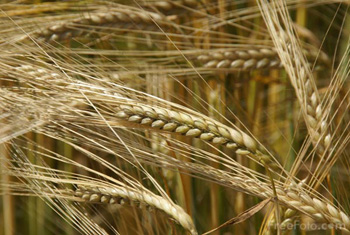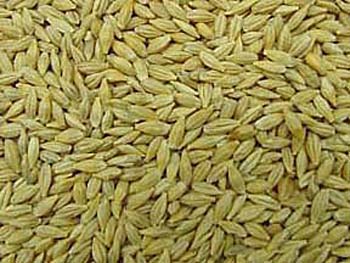Contents:
Common Names | Parts Usually Used | Plant(s) & Culture | Where Found | Medicinal Properties | Biochemical Information
Legends, Myths and Stories | Uses | Formulas or Dosages | Nutrient Content | How Sold | Warning | Resource Links | Bibliography
Scientific Names

- Hordeum vulgare L.
- Graminaceae
Common Names
- Pearl barley (hulled grain)
- Scotch barley
- Ta-mai
Parts Usually Used
Grain, germinate seeds (barley sprouts)
Back to Top
Description of Plant(s) and Culture

Barley is an annual plant; its stout, simple stem (culm) is hollow and jointed and grows from
Back to Top
Where Found

Widely cultivated as a food grain. The major producing states are North Dakota, Minnesota, South Dakota and California in the United States. In Canada, Saskatchewan, Alberta, Ontario, and Manitoba.
Back to Top
Medicinal Properties
Demulcent, digestant, carminative, nutritive
Back to Top
Biochemical Information
Amylase, invertase, dextrin, phospholipid, maltose, glucose, Iron, sulfur, phosphorus, magnesium, niacin, protein,
Back to Top
Legends, Myths and Stories
Used in manufacturing beer, malt beverages.
Barley seeds were found in tombs in Asia Minor dating from about
The earliest settlers to North American brought barley to the continent.
Back to Top
Uses
A mucilaginous substance is obtained when hulled barley (pearl barley) is cooked; good nutritional source for throat or stomach problems. The demulcent properties of cooked barley is useful in external treatment of sores, fevers, diarrhea, gout, and tumors. Used as a tonic during convalescence.
Barley water is a skin freshener, cleanses and softens skin. Made by simmering
Barley shoots are used to dry mother’s milk, treat food stagnation, weak stomach, weak digestion, loss of appetite, and hepatitis.
Back to Top
Formulas or Dosages
Decoction: was 2 oz. barley with cold water and boil in
Barley water: wash pearl barley in cold water. Boil
Back to Top
Nutrient Content
Iron, sulfur, phosphorus, magnesium, niacin, protein,
Back to Top
How Sold
Barley bread can be bought at health food stores and good bakeries. (Although, Culpeper states that barley bread is bad for melancholy people)
Back to Top
Warning
Should be avoided by nursing mothers.
Back to Top
Resource Links
LiveStrong.com: Natural Methods for Lowering Triglycerides & Cholesterol
LiveStrong.com: What Are the Benefits of Barley Grass Juice?
MayoClinic.com: Cholesterol-lowering supplements
Bibliography
![]() Culpeper’s Complete Herbal & English Physician: Updated With 117 Modern Herbs
Culpeper’s Complete Herbal & English Physician: Updated With 117 Modern Herbs, by Nicholas Culpeper, Meyerbooks, publisher, PO Box 427, Glenwood, Illinois 60425, 1990, (reprint of 1814)
![]() The Herb Book
The Herb Book, by John Lust, Bantam Books, 666 Fifth Avenue, New York, NY. copyright 1974.
![]() Chinese Medicinal Herbs
Chinese Medicinal Herbs, compiled by Shih-Chen Li, Georgetown Press, San Francisco, California, 1973.
![]() Indian Herbalogy of North America
Indian Herbalogy of North America, by Alma R. Hutchens, Shambala Publications, Inc., Horticultural Hall, 300 Massachusetts Avenue, Boston, Massachusetts 02115, 1973
 The Magic of Herbs
The Magic of Herbs, by David Conway, published by Jonathan Cape, Thirty Bedford Square, London, England. (Out of print)
![]() The Yoga of Herbs: An Ayurvedic Guide to Herbal Medicine
The Yoga of Herbs: An Ayurvedic Guide to Herbal Medicine, by Dr. David Frawley & Dr. Vasant Lad, Lotus Press, Twin Lakes, Wisconsin, Second edition, 1988.
![]() Webster’s New World Dictionary
Webster’s New World Dictionary, Third College Edition, Victoria Neufeldt, Editor in Chief, New World Dictionaries: A Division of Simon & Schuster, Inc., 15 Columbus Circle, New York, NY 10023
![]() Planetary Herbology
Planetary Herbology, by Michael Tierra, C.A., N.D., O.M.D., Lotus Press, PO Box 325, Twin Lakes. WI 53181., Copyright 1988, published 1992
![]() The Nature Doctor: A Manual of Traditional and Complementary Medicine
The Nature Doctor: A Manual of Traditional and Complementary Medicine, by Dr. H.C.A. Vogel; Keats Publishing, Inc., 27 Pine Street (Box 876) New Canaan, CT. 06840-0876. Copyright Verlag A. Vogel, Teufen (AR) Switzerland 1952, 1991
 Old Ways Rediscovered
Old Ways Rediscovered, by Clarence Meyer, Meyerbooks, publisher, PO Box 427, Glenwood, Illinois 60425, published from 1954, print 1988
